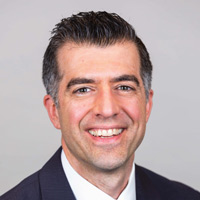What Are the Investment Opportunities and Threats in 2025?
It's the Year of the Wood Snake, representing growth, introspection, transformation and a need for patience. What could that mean for your finances?


Every 60 years, the Chinese lunar calendar combines the two symbols of wood (fostering growth) and the snake (representing wisdom and the ability to shed its skin for progress). The wood snake is a powerful combination that encourages introspection and gradual growth, according to Architectural Digest India. What does this have to do with your finances?
As we look ahead to 2025, I anticipate growth but, much like the wood snake, at a moderate pace. Forecasts for GDP growth in 2025 vary. The St. Louis Fed survey shows a consensus average of 2.1% real GDP growth in 2025. Growth, yes, but a little off from the growth rate of 2.8% in the third quarter of 2024. The fourth-quarter rate is expected by the end of January.
The economy is not the stock market. The stock market is forward-looking, anticipating growth or no growth. Possible inflection points in 2025 could come via two ways — President Donald Trump’s policies and the Federal Reserve. Will Trump give us what the stock market likes — deregulation, tax cuts, a Ukraine peace deal or not so much — policy volatility, tariffs, labor market restrictions? Or will the Federal Reserve continue to lower interest rates, or maybe — hate to say it, but it’s possible — raise rates again?
From just $107.88 $24.99 for Kiplinger Personal Finance
Become a smarter, better informed investor. Subscribe from just $107.88 $24.99, plus get up to 4 Special Issues

Sign up for Kiplinger’s Free Newsletters
Profit and prosper with the best of expert advice on investing, taxes, retirement, personal finance and more - straight to your e-mail.
Profit and prosper with the best of expert advice - straight to your e-mail.
Given the uncertainty and the fact that we are coming off of the S&P 500’s first back-to-back 20%+ annual returns since the late 1990s, stock investors could see volatility in 2025. But what does that mean for your portfolio? What should you do? Like the wood snake, now is a good time for introspection.
Step No. 1: Review your equity exposure
After two years of double-digit growth in the S&P 500 index, is your stock allocation still appropriate? Are you tilted more to equities than you should be? Reviewing your asset allocation — the mix of stocks, bonds, real estate and other investments — is important to do now, before it might be too late.
Step No. 2: Review your equity style
Many investors have narrowed their equity exposure to a few large companies. They are chasing returns in the handful of stocks that did really well in 2024. They may have little exposure to smaller companies or international stocks. That could be a problem in 2025 if other parts of the market rally. Ensure your portfolio is balanced and not overly exposed to one style of investing.
Step No. 3: Diversify beyond stocks and bonds
There’s a great investment chart I review every year — the Mercer periodic table of investments. The chart ranks the best-performing asset class each year from best to worst. It is a great visual for showing the importance of diversification. What you’ll notice is that no investment asset class stays the best-performing asset class. Commodities were one of the worst investments in 2020, but rallied in 2021 and 2022 to be in the top three. Every dog has its day. Stay diversified.
Step No. 4: Be patient
Long-term stock investors know market volatility — the ups and downs of the market — is part of the game. For putting up with the volatility, you should expect higher returns over time. If you don’t embrace volatility, or some level of risk, and choose instead to stay in cash or CDs, you should expect lower returns over time. Like the wood snake, think gradual growth, be careful about trying to time the market and be patient when investing in the stock market.
Step No. 5: Control what you can control
Investors needing returns from their stock portfolio are on shaky ground. Once the market dips, they might be more willing to sell. That’s not good. Instead, try saving more. Build the cash reserve fund. Pay down debt. Dollar-cost average into a diversified portfolio. Review if you need life or disability insurance to prevent catastrophic income loss. Minimize portfolio taxes like capital gains distributions. Save in the right accounts (401(k) with an employer match and health savings accounts (HSAs), for example). Doing all the little things adds up over time.
Parting thoughts
Like every year, we never know what the next 12 months will bring. However, if the wood snake is any guide, this is the year we need to be patient and have wisdom, and over time, growth and personal transformation are possible. Now that’s something to look forward to this year. Good luck in 2025.
To schedule a complimentary investment portfolio review with the author, visit Portfolio Review Call.
Michael Aloi, CFP, is an independent financial adviser with 25 years of experience in helping clients achieve their financial goals. He works with clients throughout the United States. For more information, please visit www.michaelaloi.com.
Investment advisory and financial planning services are offered through Summit Financial LLC, an SEC Registered Investment Adviser, 4 Campus Drive, Parsippany, NJ 07054. Tel. 973-285-3600 Fax. 973-285-3666.
This material is for your information and guidance and is not intended as legal or tax advice. Clients should make all decisions regarding the tax and legal implications of their investments and plans after consulting with their independent tax or legal advisers. Individual investor portfolios must be constructed based on the individual’s financial resources, investment goals, risk tolerance, investment time horizon, tax situation and other relevant factors. Past performance is not a guarantee of future results.
The views and opinions expressed in this article are solely those of the author and should not be attributed to Summit Financial LLC. Links to third-party websites are provided for your convenience and informational purposes only. Summit is not responsible for the information contained on third-party websites. The Summit financial planning design team admitted attorneys and/or CPAs, who act exclusively in a non-representative capacity with respect to Summit’s clients. Neither they nor Summit provide tax or legal advice to clients. Any tax statements contained herein were not intended or written to be used, and cannot be used, for the purpose of avoiding U.S. federal, state or local taxes.
Related Content
- Market Volatility: Creating an Adaptable Retirement Plan
- One Retiree's Story of How She Built Her Retirement Nest Egg
- Five Ways to Minimize a Higher Capital Gains Tax Rate
- Four Tips to Help You Conquer the Retirement Mountain
- Whole Life Insurance: A Multipurpose Financial Planning Tool
Profit and prosper with the best of Kiplinger's advice on investing, taxes, retirement, personal finance and much more. Delivered daily. Enter your email in the box and click Sign Me Up.

Michael Aloi is a CERTIFIED FINANCIAL PLANNER™ Practitioner and Accredited Wealth Management Advisor℠ with Summit Financial, LLC. With 21 years of experience, Michael specializes in working with executives, professionals and retirees. Since he joined Summit Financial, LLC, Michael has built a process that emphasizes the integration of various facets of financial planning. Supported by a team of in-house estate and income tax specialists, Michael offers his clients coordinated solutions to scattered problems.
-
 The Rule of Compounding: Why Time Is an Investor's Best Friend
The Rule of Compounding: Why Time Is an Investor's Best FriendDescribed as both a "miracle" and a "wonder," compound interest is simply a function of time.
-
 4 Great Tools to DIY Your Own Financial Plan
4 Great Tools to DIY Your Own Financial PlanSmart Savings Several tools picked out by Kiplinger that DIYers can use to make their own financial plan.
-
 The 7-Month Deadline That Sets Your Lifetime Medicare Premiums
The 7-Month Deadline That Sets Your Lifetime Medicare PremiumsUnderstanding Medicare enrollment is crucial, as missing deadlines can lead to permanent late enrollment penalties and gaps in coverage.
-
 The Rule of Compounding: Why Time Is an Investor's Best Friend
The Rule of Compounding: Why Time Is an Investor's Best FriendDescribed as both a "miracle" and a "wonder," compound interest is simply a function of time.
-
 If You're a U.S. Retiree Living in Portugal, Your Tax Plan Needs a Post-NHR Strategy ASAP
If You're a U.S. Retiree Living in Portugal, Your Tax Plan Needs a Post-NHR Strategy ASAPWhen your 10-year Non-Habitual Resident tax break ends, you could see your tax rate soar. Take steps to plan for this change well before the NHR window closes.
-
 Stocks Chop as the Unemployment Rate Jumps: Stock Market Today
Stocks Chop as the Unemployment Rate Jumps: Stock Market TodayNovember job growth was stronger than expected, but sharp losses in October and a rising unemployment rate are worrying market participants.
-
 The Delayed November Jobs Report Is Out. Here's What It Means for the Fed and Rate Cuts
The Delayed November Jobs Report Is Out. Here's What It Means for the Fed and Rate CutsThe November jobs report came in higher than expected, although it still shows plenty of signs of weakness in the labor market.
-
 Your Year-End Tax and Estate Planning Review Just Got Urgent
Your Year-End Tax and Estate Planning Review Just Got UrgentChanging tax rules and falling interest rates mean financial planning is more important than ever as 2025 ends. There's still time to make these five key moves.
-
 What Makes This Business So Successful? We Find Out From the Founder's Kids
What Makes This Business So Successful? We Find Out From the Founder's KidsThe children of Morgan Clayton share how their father's wisdom, life experience and caring nature have turned their family business into a respected powerhouse.
-
 Stocks Struggle Ahead of November Jobs Report: Stock Market Today
Stocks Struggle Ahead of November Jobs Report: Stock Market TodayOracle and Broadcom continued to fall, while market participants looked ahead to Tuesday's jobs report.
-
 Past Performance Is Not Indicative of Your Financial Adviser's Expertise
Past Performance Is Not Indicative of Your Financial Adviser's ExpertiseMany people find a financial adviser by searching online or asking for referrals from friends or family. This can actually end up costing you big-time.